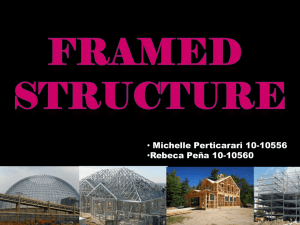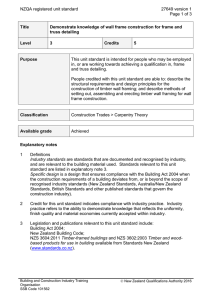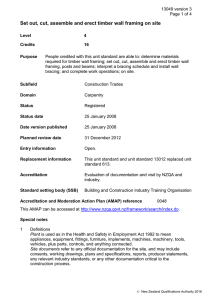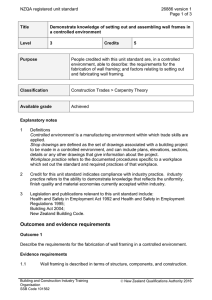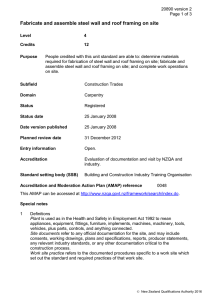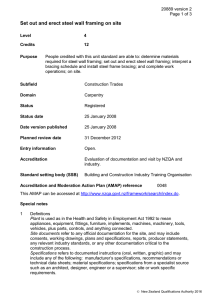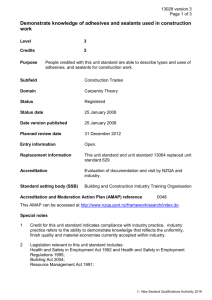Demonstrate knowledge of setting out, assembling and erecting timber
advertisement
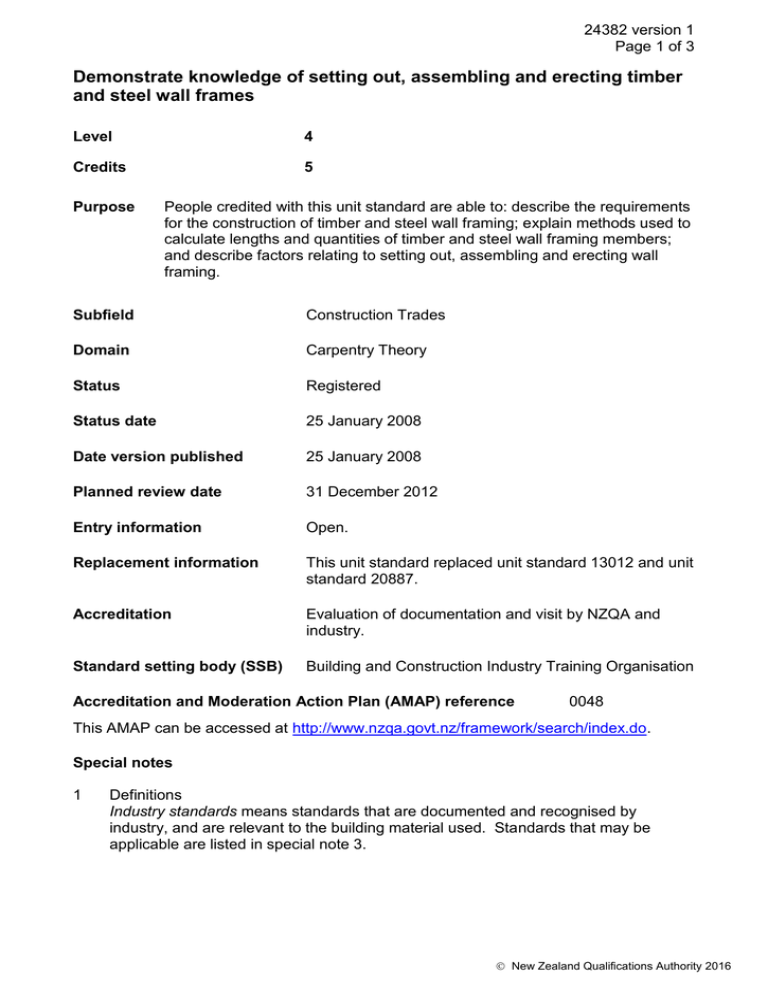
24382 version 1 Page 1 of 3 Demonstrate knowledge of setting out, assembling and erecting timber and steel wall frames Level 4 Credits 5 Purpose People credited with this unit standard are able to: describe the requirements for the construction of timber and steel wall framing; explain methods used to calculate lengths and quantities of timber and steel wall framing members; and describe factors relating to setting out, assembling and erecting wall framing. Subfield Construction Trades Domain Carpentry Theory Status Registered Status date 25 January 2008 Date version published 25 January 2008 Planned review date 31 December 2012 Entry information Open. Replacement information This unit standard replaced unit standard 13012 and unit standard 20887. Accreditation Evaluation of documentation and visit by NZQA and industry. Standard setting body (SSB) Building and Construction Industry Training Organisation Accreditation and Moderation Action Plan (AMAP) reference 0048 This AMAP can be accessed at http://www.nzqa.govt.nz/framework/search/index.do. Special notes 1 Definitions Industry standards means standards that are documented and recognised by industry, and are relevant to the building material used. Standards that may be applicable are listed in special note 3. New Zealand Qualifications Authority 2016 24382 version 1 Page 2 of 3 Specific design is a design that ensures compliance with the Building Act 2004 when the construction requirements of a building deviates from, or is beyond the scope of recognised industry standards (New Zealand Standards, Australia/New Zealand Standards, British Standards and other published standards that govern the construction industry). 2 Credit for this unit standard indicates compliance with industry practice. Industry practice refers to the ability to demonstrate knowledge that reflects the uniformity, finish quality and material economies currently accepted within industry. 3 Legislation and publications relevant to this unit standard include: Health and Safety in Employment Act 1992 and Health and Safety in Employment Regulations 1995; Building Act 2004; Resource Management Act 1991; New Zealand Building Code; NZS 3604:1999 Timber Framed Buildings, available from Standards NZ (http://www.standards.co.nz); National Association of Steel Framed Housing (NASH) 3405 Design and Construction Guide (Non-specific), available from NASH NZ, PO Box 76 134, Manukau City. Elements and performance criteria Element 1 Describe the requirements for the construction of timber and steel wall framing. Performance criteria 1.1 Wall framing members are identified in terms of their location and purpose. Range 1.2 plates, including raking plates; studs and jacks studs; trimmers, lintels, beams, dwangs (noggings), ribbon boards, posts, bracing. Methods of achieving bracing requirements are described in accordance with industry standards and manufacturer’s recommendations. Range sheet diaphragm, metal angle, proprietary systems. Element 2 Explain methods used to calculate lengths and quantities of timber and steel wall framing members. Performance criteria 2.1 Methods of calculating lengths and quantities of material required for wall framing are described, and accurate sample calculations performed in accordance with industry practice. New Zealand Qualifications Authority 2016 24382 version 1 Page 3 of 3 Element 3 Describe factors relating to setting out, assembling and erecting timber and steel wall framing. Range single and two storey. Performance criteria 3.1 Methods of setting out wall framing members are described in accordance with the requirements of industry standards or specific design. Range 3.2 The methods of assembling and erecting wall framing members are determined and described in accordance with industry standards or specific design. Range 3.3 plates, including raking plates; studs and jack studs; trimmers, lintels, beams, dwangs (noggings), ribbon boards, posts, bracing. use of connectors, provision for bracing elements, temporary bracing. Procedures for maintaining health and safety requirements when constructing and erecting wall framing are described. Range work methods, plant, equipment, identification of hazards and controls. Please note Providers must be accredited by NZQA, or an inter-institutional body with delegated authority for quality assurance, before they can report credits from assessment against unit standards or deliver courses of study leading to that assessment. Industry Training Organisations must be accredited by NZQA before they can register credits from assessment against unit standards. Accredited providers and Industry Training Organisations assessing against unit standards must engage with the moderation system that applies to those standards. Accreditation requirements and an outline of the moderation system that applies to this standard are outlined in the Accreditation and Moderation Action Plan (AMAP). The AMAP also includes useful information about special requirements for organisations wishing to develop education and training programmes, such as minimum qualifications for tutors and assessors, and special resource requirements. Comments on this unit standard Please contact the Building and Construction Industry Training Organisation national.office@bcito.org.nz if you wish to suggest changes to the content of this unit standard. New Zealand Qualifications Authority 2016
